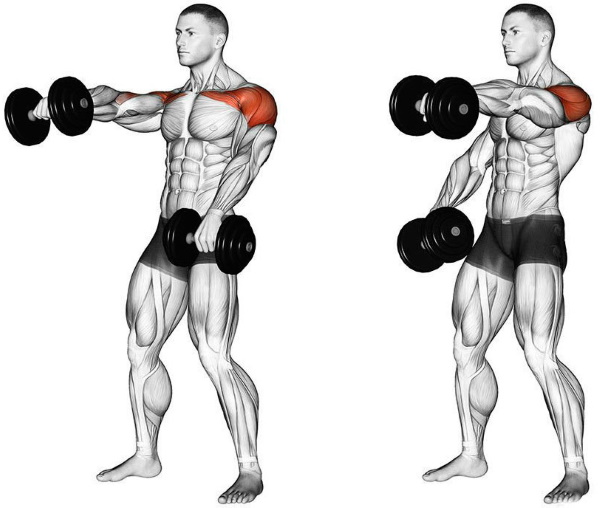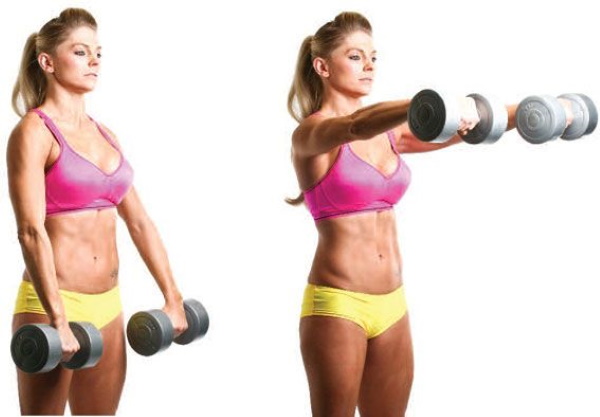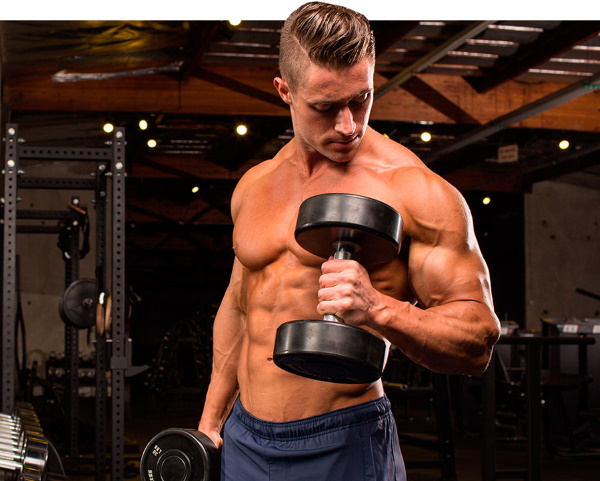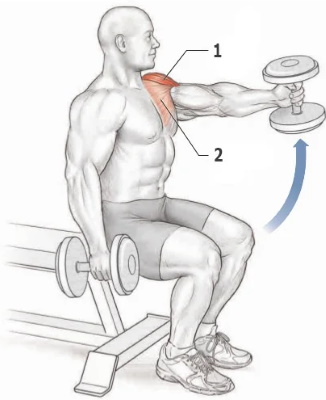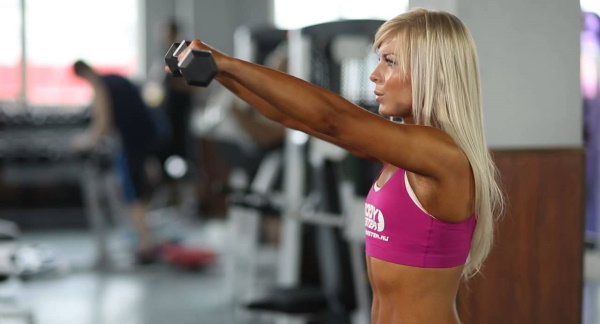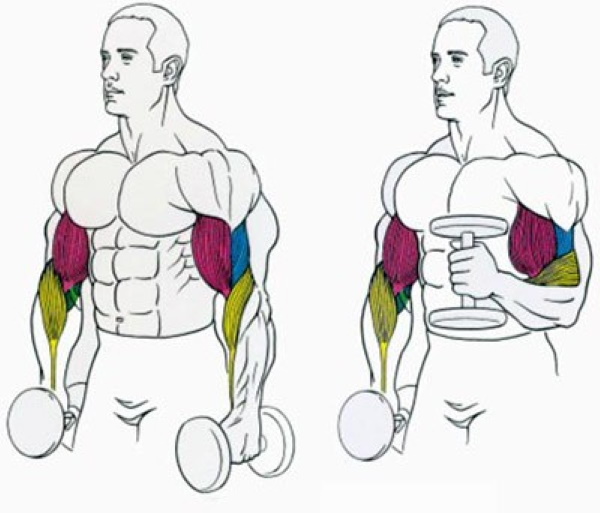Broad shoulders are one of the main signs of an athletic figure.... However, developed deltoid muscles contribute not only to the formation of a harmoniously developed figure, but also ensure the correct posture of a person. A proportional and symmetrical increase in the volume of this part of the body is impossible without the use of special isolating movements. A key role in training the front beam of deltas is played by lifting dumbbells in front of you.
What muscles are involved in lifting the dumbbells in front of you?
Raising the dumbbells in front of you is an isolation single-joint exercise. It is widespread among men and women involved in sports. The high popularity of the athletic movement is due to its effectiveness and versatility. While lifting dumbbells in front of you, several large muscle groups are involved at once.
They bear 2 types of load:
- Static.
- Dynamic.
The main dynamic load falls on the anterior deltoid muscle bundle. In this case, the back and middle beams also do the work. They keep the humerus in the anatomically correct position. During the exercise, the pectoral muscles are included in the work. With a classic grip and a standard trajectory of movement of the arms, the upper chest beam is loaded. When turning the dumbbells and bringing them down at the top point, the lower part of the pectoralis major muscle is isometrically strained.
The static load is distributed between the core muscles. In this athletic movement, the abdominals and long back extensors hold the body upright. If the exercise is performed while standing, then the legs begin to actively engage in the work. The quadriceps of the thigh, gluteus maximus, and the hamstrings are static. The iliopsoas muscle is also included in the work. One of the functions of which is to keep the body upright.
Advantages and disadvantages of exercise
The main advantage of front delta lifts is their simplicity. The movement technique is easy to master. If the necessary requirements are fulfilled, the exercise is not traumatic. The main disadvantage is its low efficiency. Beginner athletes use it as a tool for gaining muscle mass.
Technical highlights
Lifting dumbbells in front of you, despite its apparent simplicity, is a technically difficult athletic movement. When performing it, you must pay attention to many details and follow a wide range of recommendations. Depending on the grip and the number of upper limbs involved in the exercise, the following types of swing movements with dumbbells on the front delta are distinguished.
Dumbbell grip
There are 3 main types of grip that are widespread:
- Straight or top... In this case, the hand tightly covers the sports equipment from above. The palm is directed towards the athlete, and at the top point of the amplitude looks towards the floor. In this case, the thumb of the loaded limb should cover the bar of the dumbbell from the opposite side in relation to the hand itself. As a result, a kind of lock is formed, which reliably fixes the sports equipment in the hand. The use of an open grip is not allowed. In this case, the thumb of the hand is pressed against the index finger and covers the bar of the dumbbell from above. Such a grip can lead to the equipment slipping out and injury.
- Hammer... With this grip, the hands are turned outward in such a way that at the starting point of the movement the thumb is directed away from the exercising person and looks forward (partial supination with a turn of the palm 90 degrees from the normal). In this case, it is recommended to use a closed grip with the thumb overlapping the bar of the dumbbell. Despite the more stable position of the sports equipment in the athlete's hand, the risk of weight loss when using open grips is very high.
Raising dumbbells in front of you, hammer technique. - Reverse grip... This option is used when training pectoral muscles in conjunction with deltas. The reverse grip provides for full supination of the hand at the elbow joint. In this case, the thumbs of both hands are turned in opposite directions, the palms themselves are pointing up. This technique for lifting dumbbells in front of you provides for a trajectory of movement that is different from the classic version.
Amplitude of motion
Depending on the range of motion, there are 3 main types of lifting dumbbells in front of you:
| Full amplitude. | Starting position - arms straight and down. To perform full swing swings, a direct closed grip is used. The movement continues until the arms reach the top point above the head. In this case, the amplitude is about 180 °. |
| Partial amplitude or half. | The dumbbells are lifted until the bunches reach a line parallel to the floor. In this case, both straight and hammer grip can be used. |
| Half amplitude offset to the midline of the body. | To perform this version of the exercise, only the reverse grip is used. The arms at the elbows should be bent, and the thumbs should tightly wrap the bar of the dumbbell from the back side, forming a lock. When moving upward, the arms are shifted to the center. At the top point, their mutual contact occurs. |
Lift options
Lifting dumbbells to the front delta can be done while sitting or standing. In both cases, the movement is carried out in front of oneself, that is, in the frontal plane.
Sitting
When performing the exercise in a sitting position, the static load is removed from the lower half of the body. The legs are relieved, and the back extensors and abdominals are less stressed. The athlete has the opportunity to concentrate on the work of the target muscle groups.
However, the very process of performing the movement changes. At the lowest point of the amplitude, the arms with dumbbells, due to the arisen interference in the form of knees bent and extended forward, should turn and shift to the sides of the body. This forces the practitioner to concentrate more on turning the hands and maintaining tension in the deltas.
Standing
Raising dumbbells in front of you from a standing position is suitable for trained athletes. Moving the hand in front of you, even with a slight burden, exerts a tangible load on all stabilizer muscles. And since swinging with dumbbells is a dynamic and explosive exercise, the muscles of the back, abdomen and legs of the athlete who are not prepared for serious work can be damaged or injured.When performing lifts to the front bundles of the deltoid muscles from a standing position, you should perform a high-quality warm-up not only of the main, but also of the auxiliary muscles.
Technique for performing lifts in front of you
The peculiarities of the lifting technique depend on the type of grip, the number of dumbbells used during the exercise, and the position of the athlete in space (sitting or standing). The features of performing the exercise from the sitting and standing positions were discussed above.
The classic version of lifting dumbbells with two hands
An exercise in which a person engaged in a gym operates with two dumbbells at the same time is considered a classic exercise. In this case, it is allowed to use any of the grip options discussed above. The technique of performing an athletic movement will not change from this. The main load will slightly shift from the anterior deltas to the pectoral muscles during the transition from the maximally pronated grip (the thumbs are directed towards each other) to the maximally supinated (the thumbs of both hands look in opposite directions, and the palms are directed up).
Basic recommendations on the technique for performing the classic version of lifting dumbbells with two hands on the deltas:
- Initial position... The back should be straight. The shoulders are straightened. The shoulder blades are brought together. Due to this, the shoulders are pulled back a little, and the joint takes its natural position. Shoulder-blade reduction is also important in terms of maintaining correct posture. The development of body musculature with curvature and stoop only leads to a more pronounced manifestation of figure flaws. Therefore, at the initial stage, it is important to pay attention not only to the technique of movement and muscle work, but also to maintain the correct starting position throughout the entire workout.
- Dumbbells... Dumbbells are taken in both hands. In this case, the grip must be closed. Thumbs wrap around the bar of the sports equipment from the outside and press tightly against the index fingers of each hand. This type of grip reduces the risk of the dumbbell falling out of your hands.
- Start of movement... To start the movement, you need to take the starting position and take the dumbbells. In this case, the arms should be lowered down and slightly bent at the elbows. A slight bend in the joint is necessary to transfer the load directly from the joint to the muscles of the shoulder, forearm and tendons of the forelimbs. Relieving stress will help maintain the health of the elbows and their performance.
- Upward movement... The traditional version of swings with two dumbbells allows you to perform the exercise both in full amplitude and from lifting a sports equipment to chest level. In both cases, the movement should be performed at an even pace. Swaying of the body should be avoided, as well as the breakdown of dumbbells from the bottom point with the help of legs. It is necessary to monitor the position of the back. The thoracic spine should not be rounded. The shoulder blades remain flattened.
- Lowering the weight down... When you reach the top point, you should make a short pause of no more than 1-2 seconds. and start lowering the dumbbells down. In this case, the hands should move synchronously. Sharp throws are not allowed. Movement should be controlled. At the lowest point, dumbbells should not be allowed to touch the hips. You should maintain tension in the deltoid muscles from the beginning of the approach to its completion.
Alternating lifting option
The alternate raising of arms with dumbbells to the front bundle of deltas is identical in technique to the previous version.
However, there are several things to consider when performing this type of this athletic movement:
- Axial loads on the spine increase with alternate lifting of arms with dumbbells. When performing this version of the exercise, athletes use a slightly larger weight of weights than with classic lifts. In addition, there is no symmetry during the exercise.The bending load on the spine increases. Therefore, alternating swings should not be performed by people with kyphosis or scoliosis.
- Alternating delta climbs are performed at an explosive pace. In order to give the necessary impulse to a heavier dumbbell, practitioners involuntarily allow the body to swing. This is a technical error. To prevent such an error, this swing option should be performed from a sitting position.
Front lifting one dumbbell in front of you to work out the shoulders
Lifting a dumbbell in front of you is another variant of swinging movements to the front bundle of deltoid muscles. The main feature of this type of exercise is the way of fixing the sports equipment in the hands. When performing the movement, one dumbbell is used. However, it is fixed on straight arms extended in front of the chest. The hands cover the bar, squeezing it tightly together. In this case, the risk of inventory falling out is minimal.
The arms brought to the center also allow you to engage the chest muscles, creating isometric tension in them:
- Initial position. The exercise is performed from a standing position. The body must be straightened, the blades must be brought together. The chest is pulled forward slightly. The hands are wrapped around the bar with the thumbs on top. In this case, the dumbbell is fixed with a closed grip.
- The upward movement starts from the waist and continues until the sports equipment reaches chest level. It is important to maintain a slight bend in the elbow joints of both limbs.
- Downward movement begins after a short pause. It is not allowed to throw the sports equipment down. This phase of the exercise should be done in a controlled manner. The dumbbell should move down the same trajectory along which it climbed up. At the lowest point of the amplitude, do not allow the dumbbell to touch the hips.
Swing dumbbells in front of you while standing
Lifting dumbbells in front of you while standing is also called swing. Some visitors to sports complexes understand swinging as moving weights using the cheating technique, that is, a slight swing of the body. However, this loses all sense of doing deltas. Swings can be performed using one or two dumbbells.
Front delta exercises
Lifting the weights in front of you is not the only exercise for developing the deltoid muscle.
The front bundle of shoulder muscles is actively involved in the work when performing various options for pressing exercises:
- Bench press on a horizontal bench.
- Overhead press.
- Press on an incline bench. The degree of delta involvement is regulated by the angle of inclination. The larger it is, the more the front deltas are involved in the work.
Features of including exercise in the training program
Raising the dumbbells in front of you is an isolated movement. It is aimed at shaping and drawing the front beam of deltas. For best results, it should be done immediately after heavy basic movements. Or include in complexes together with one of the athletic movements listed in the previous subparagraph.
Frequent mistakes and recommendations when lifting dumbbells
The most common mistake people make when starting out in the gym is using unreasonably large dumbbells. The purpose of lifts is to purposefully and isometrically strain the target muscle group throughout the entire range of motion. To perform the exercise efficiently, it is enough to use dumbbells weighing 5-6 kg for men and 2-3 kg for women.
It is worth starting to practice lifting dumbbells in front of you no earlier than the 3rd - 4th month after the start of training. This exercise should be included in the sports program in conjunction with other basic movements.At the same time, close attention must be paid not only to working muscles, but also to maintaining the correct posture. If the muscles of the athlete's core are poorly developed, then preference should be given to the option of performing from a sitting position.
Exercise video lifting dumbbells in front of you
Features of the exercise, technique:

